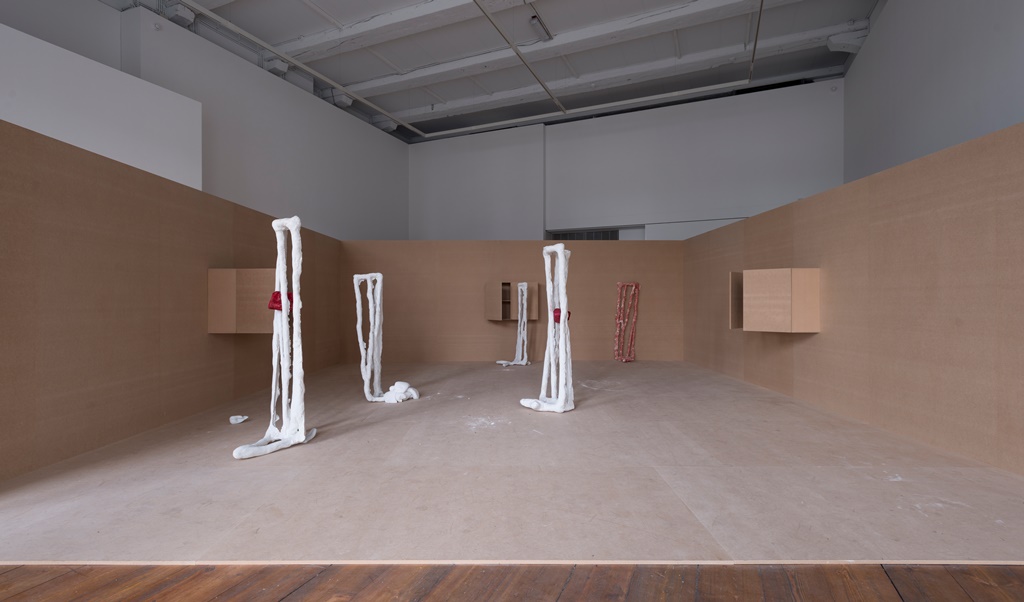
Michael Dean Qualities of Violence


The press release, for the latest Michael Deans’ solo presentation Qualities of Violence at de Appel arts center in Amsterdam, consists dictionary definitions of the title’s keywords. Possible designations of their meaning. But what do the “quality” and “violence” mean in the rhetoric of this exhibition?
Michael Dean’s body of work is a dictionary of his own, imaginary language. A dictionary, which vocabulary does not need a translation but rather transposition from one form to the other, without changing its definition. It is a lexicon that works more on a basis of picture dictionary than the verbal translation.
Over the time of his artistic practice Dean has developed his own language, which is based on a series of typographic alphabets designed by himself. This particular parlance is mediated not only through his writings and performances but it manifests itself also in a physical forms of his photographs and sculptures. Transmutation of spoken or written language into objects is taking place. Can the viewer be a reader then?
When entering the space of the show, at the foyer, the visitor is faced with ripped pages of the book, strewn around like after a huge draft along with deflated black balloons, as left a few days after the party. They look like covered with dust, forgotten and abandoned. It’s a prologue. Paraphrasing Maurice Blanchot, who talked about the space of literature – it’s like a place where someone dies: a nowhere, which is here. Similar, ghostly atmosphere is perceptible all along the exhibition.


In each room of the gallery an alternate one has been built – a MDF construction, between and betwixt a theater stage and home-like environment. In one of the rooms the floor is covered with one-cent coins that echoes filled with ground Walter de Maria’s Earth Room. Inside and outside of the structures different objects – photographs, sculptures, artifacts – inhabit (occupy?) the space. They stay still and mute. Rather observing than participating in what is happening around.
The visual aesthetic of the settings evokes a spirit of archeological excavations. Sculptures bring to mind giant fossils, stalactites or stones. But at the same time it could be bones, tongues or limbs. The structure of the surfaces take on a peculiar quality, brutalist and organic at once. It looks like stone or copper covered with patina, but also resembles veins or even blood. Although made mostly out of concrete, artificial stone-like material, through their size and positioning in the space – they seek a direct relation with a human body. The materiality of communication. Even the photograph on the ground floor shows hands put between the elements of one of the sculptures – as if demonstrating the possible physical interaction with works. Only that we cannot get closer to them until we find the mutual understanding, the way how to communicate. The objects are like unknown dialect, which meaning we try to understand only by resemblance to the words or shapes that we already know.
Here and there on the floor are books or torn pieces of paper. Accompanying the sculptural figures they give a hope to obtain an explanation and meaning. In fact they are written in unrecognizable language that doesn’t allow for straightforward recognition.
The show doesn’t seem to give a visitor a warm welcome. It leads its own life and doesn’t need a spectator in order to do that. And in this regard it resembles a book, which protagonists live irrespective of the reader, no matter where he or she opens the book and starts to read.
“I wanted to write objects that I could leave and then come back to with a sense that I was looking at them for the first time.” said Michael Dean. And indeed, it’s about the moment of encounter. Even though sculptural elements might act as they are to fill the gap between the realization of the project and telling the story behind it, in fact the narrative doesn’t matter. Comparing again to the structure of the book it has more in common with the table of contents or index than plot per se.
The way how the objects are placed makes the viewer aware of his/her physicality in space. Moving between, being on and outside the ‘stage’ – designate the Dean’s universe, where sculptures become words and vice versa. Also, because of the quality of used material – concrete that is not very well protected – the visitor leaves own traces. Thus the viewer creates own language, which allows to move through and read the “Qualities of Violence”.


Michael Dean
Qualities of Violence
de Appel, Amsterdam
24.01 – 10.05.2015
Images: courtesy De Appel
Weronika Trojanska
is an artist and art writer


